
A Software Bill of Materials (SBOM) is a transparent accounting of a supply chain that’s increasingly complicated and in which security is increasingly paramount. A compromised component of the supply chain can impact consumers downstream, leaving organizations to wonder whether they’re affected and if so, where? SBOMs answer both questions quickly. Ideally, SBOMs help organizations get clarity faster in case of attack. What do they reveal, and are SBOMs enough? We’re breaking down these modern security tools.
What is SBOM?
An SBOM is a detailed inventory that lists all components, dependencies, and their versioning within a software application. It provides foundational visibility into what software assets are deployed — including libraries, packets, and modules — facilitating rapid identification of vulnerabilities, regulatory compliance, and supply chain risk management within complex cloud ecosystems.
SBOM addresses the growing connectedness of modern software deployments, where third-party code, open-source projects, and interdependent services are the norm. Without a clear inventory, organizations lack visibility into what’s embedded in their software.
Mapping software assets as they are deployed facilitates multiple organization and security goals, including:
- Risk identification and containment
- Supply chain security
- Regulatory compliance
- Operational efficiency
As an actionable list, the SBOM enhances visibility into the software supply chain and is a proactive method for managing security risks.
Combine Static SBOMs with Dynamic Cloud Security
Upwind offers runtime-powered container scanning features so you get real-time threat detection, contextualized analysis, remediation, and root cause analysis that’s 10X faster than traditional methods.
Benefits and Limitations of SBOMs
Open-source software is the heart of most software builds today, and because it can be distributed and downloaded multiple times over, tracking its origins can be challenging. Yet this code forms the backbone of business-critical software.
Open-source software, created publicly and distributed for free, comprises around 96% of codebases today.
SBOMs address this challenge, helping with visibility into the origin, version, and dependencies of each piece of code. That transparency is valuable for managing compliance, especially as open-source components may not have consistent or centralized oversight. Let’s break down the primary SBOM benefits and how teams can both harness and be challenged to achieve them:
Comprehensive Visibility Management
SBOMs offer a detailed view of every component and dependency in a software application, enabling teams to detect vulnerabilities in both direct and transitive dependencies. This insight allows for targeted remediation, reducing risks across complex software stacks.
To maximize this benefit, teams must keep SBOMs up-to-date, as outdated SBOMs can miss recent changes, making it challenging to manage dependencies accurately in rapidly evolving cloud-native applications.
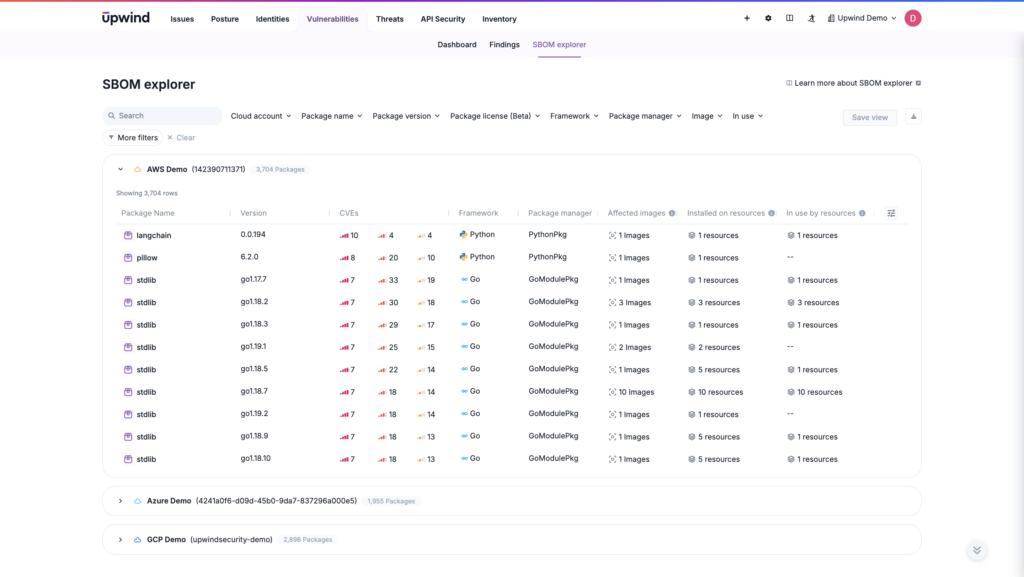
Supply Chain Risk Mitigation
SBOMs provide visibility into the origins of each software component, helping teams identify risks from third-party or open-source dependencies. This visibility helps defend against supply chain attacks, especially as cloud-native applications rely on an extensive network of external code.
Tracking and securing all third-party components is no small feat. Teams may need automated tools and processes to ensure that all dependencies are continuously monitored and assessed for potential threats.
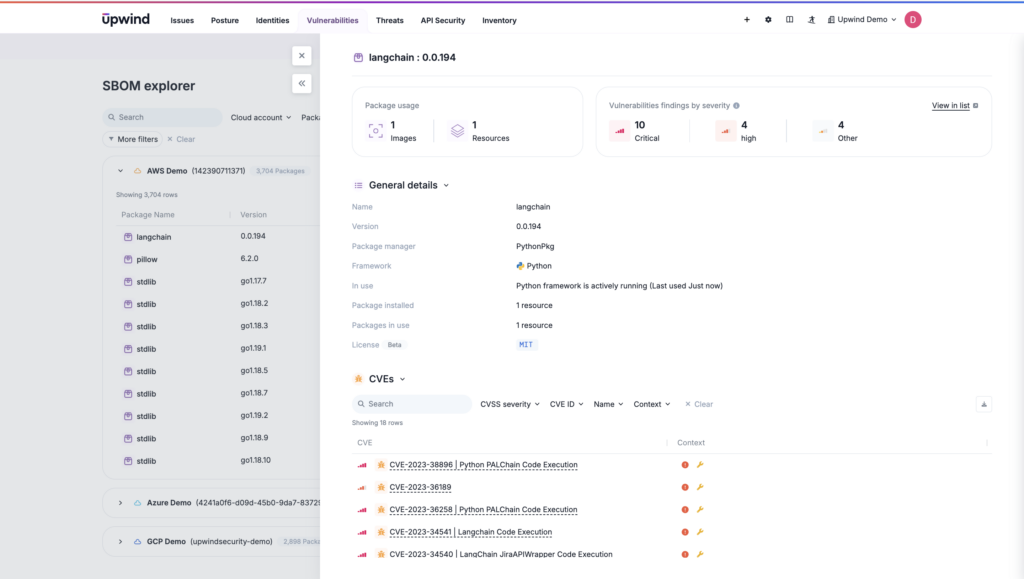
Enhanced Incident Response
During an incident, an SBOM allows teams to quickly identify affected components, speeding containment. This deep understanding of software components minimizes the scope of a breach, helping security teams isolate only those dependencies impacted by an attack.
Without real-time insights, SBOMs can limit the accuracy of incident response. Teams may need to integrate runtime monitoring to capture live component activity and realize an effective incident response in dynamic cloud environments.
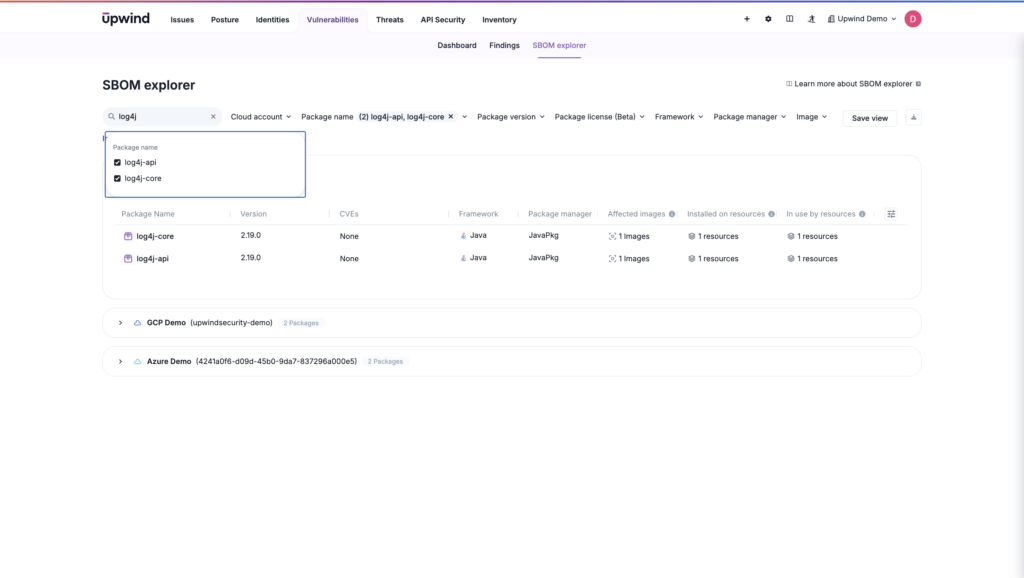
Automated Compliance and Governance
SBOMs simplify compliance with industry regulations. After all, they catalog all components and licenses, ensuring each element adheres to regulatory standards. That reduces manual tracking, easing the compliance burden for teams.
However, compliance needs can change frequently, and SBOMs must be maintained to reflect the latest standards. This requires teams to have continuous compliance checks. Automating these updates avoids gaps in regulatory adherence.
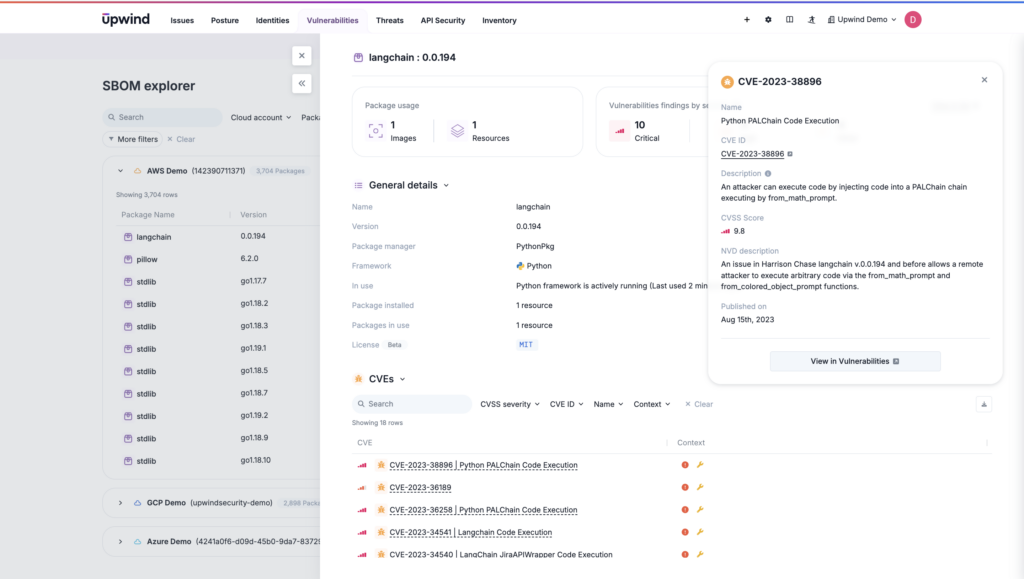
Streamlined Cloud Asset Management
In cloud-native environments, SBOMs help teams manage component changes, minimizing configuration drift and enabling consistent security across all assets. This visibility into what’s deployed helps prevent untracked dependencies from introducing risks.
Teams can struggle to manage frequent updates to cloud-native applications, and keeping SBOMs accurate requires robust integration with the CI/CD pipeline. Without continuous updates, SBOMs can become outdated, limiting their value for cloud asset management. Today, there are also commercial solutions that provide consistent SBOM updates. For example, Upwind provides SBOMs at runtime, which are continuously updated, as well as integrations with CI/CD pipelines.
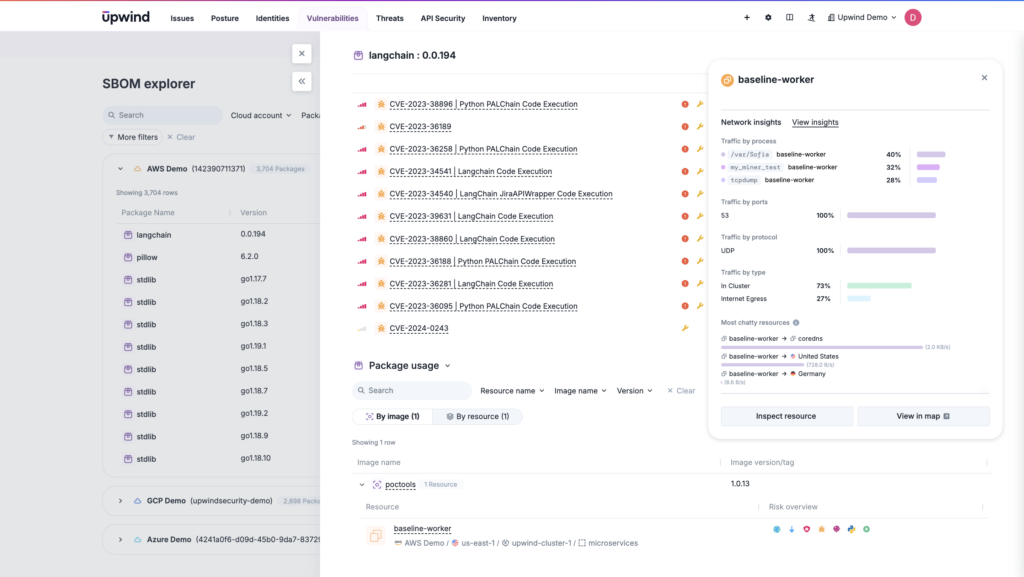
Proactive Threat Detection and Monitoring
On their own, SBOMs offer a protective layer of threat detection by identifying and cataloging all components in an application, which allows teams to anticipate potential vulnerabilities based on a component age, unpatched dependencies, or known exploit patterns.
By combining SBOM data with real-time monitoring, teams can go beyond static snapshots to actively track component health and behavior. This integration sharpens threat detection, allowing teams to catch vulnerabilities before they become serious threats.
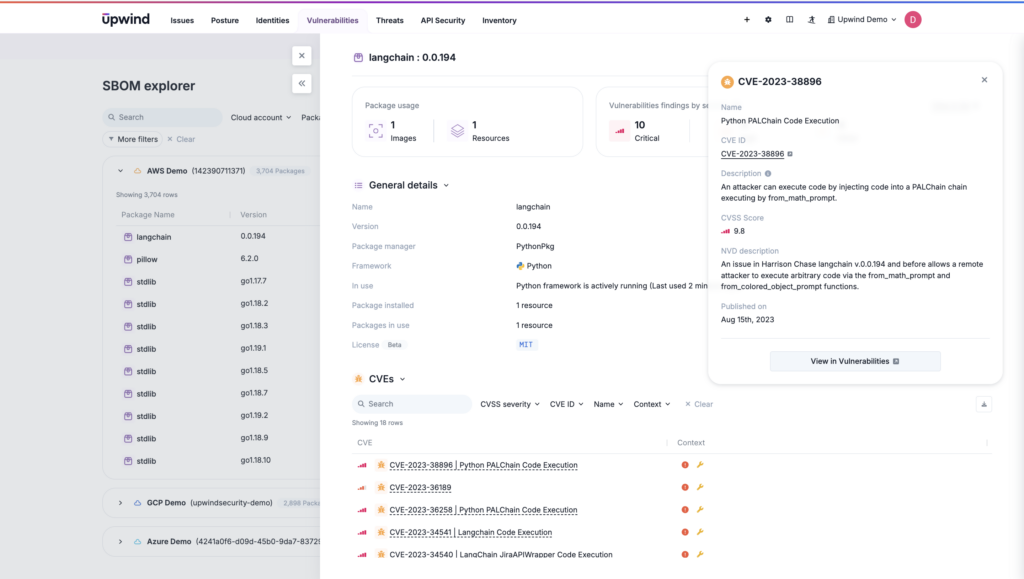
Beyond SBOMs: Alternative of Complementary Approaches for Deeper Security
While SBOMs provide valuable insights into the components of an application, many teams may wonder if there are other or even better ways to gain visibility and manage risks within cloud-native environments.
Ultimately, SBOMs are powerful for static inventory management, but dynamic, complex systems often require additional tools and strategies that can go deeper or adapt in real time.
The table below outlines complementary or alternative approaches to SBOMs, highlighting their strengths, limitations, and best-use scenarios. These tools — whether focused on runtime protection, configuration scanning, or dependency analysis — can fill the gaps SBOMs might leave, offering a more holistic approach to application security and risk management.
| Approach | Benefits | Limitations | Best Use Cases |
| Dynamic Application Security Testing (DAST) | Detects runtime vulnerabilities by simulating attacks, catches issues SBOMs may miss | Can only identify exploitable vulnerabilities, can’t see dependencies pre-deployment | Best for real-time vulnerability detection in applications with rapidly changing components or high external exposure |
| Runtime Application Self-Protection (RASP) | Monitors and defends against attacks from within the app itself, adapting in real time | Resource-intensive, may slow application performance | Ideal for applications with sensitive data or where runtime security is prioritized |
| Cloud Security Posture Management (CSPM) | Identifies misconfigurations and compliance issues in cloud environments | Focuses on cloud infrastructure, so it doesn’t replace code-level insights of SBOMs | Made for comprehensive cloud security and compliance |
| Software Composition Analysis (SCA) | Identifies and assesses risks in open-source and third-party code dependencies | Primarily scans code and dependencies, less effective for runtime insights | Complementary to SBOMs, ideal for organizations heavily using open-source components, where licensing and dependency tracking are crucial |
Each approach provides unique layers of security and works best in specific contexts. Combining these solutions or adopting a more comprehensive CNAPP solution balances proactive protection with runtime monitoring and can best reduce an organization’s risk profile.
Ongoing Challenges with SBOMs
Despite the strengths of SBOMs, several persistent challenges can impact their effectiveness in complex environments.
- Identifying and naming software components
With thousands of open-source and third-party components available, standardized naming conventions are still inconsistent. That creates blind spots in vulnerability tracking and complicates cross-referencing component information with vulnerability databases. Without a universal naming standard, two teams might list the same component differently, leading to inaccurate risk assessments. Addressing this requires enhanced tooling or standard frameworks, both of which are evolving to meet the challenge.
- Deciding what to include in an SBOM
Not every component holds equal weight in terms of risk. Determining the depth of information, for instance, whether to include minor utilities, libraries, or supporting files, can influence an SBOM’s usefulness. Overly detailed SBOMs can overwhelm security teams, while under-detailed ones miss critical components. How many components should be included? That’s still a matter of debate. In high-risk industries, defining the scope of SBOMs becomes a strategic decision, balancing comprehensiveness with actionable insight.
- Supplier identification
In cloud-native environments, dependencies are frequently layered and complex, and suppliers may not always be transparent or easily identifiable. For example, a third-party library might itself rely on several open-source components, each introducing potential vulnerabilities. Without clear supplier identification, security teams may not be able to assess supply chain integrity.
- Sharing and exchanging SBOMs
Sharing SBOMs across teams poses logistical and security challenges. If SBOMs are not easily transferable or readable by external tools, organizations may face compatibility issues, limiting collaboration and weakening broader security initiatives. Further, sharing sensitive details within an SBOM must be done carefully to avoid exposing vulnerabilities or intellectual property. Solutions like standardized formats (e.g., SPDX or CycloneDX) can facilitate exchange, but adoption is not universal.
Upwind Shines a Light on Dependencies
SBOMs provide essential transparency to fuel faster, more successful security decisions. But they’re not perfect. Upwind helps make SBOM inventories actionable, integrating SBOM capabilities that streamline component tracking. Combining SBOM insights with real-time monitoring, Upwind equips organizations with the tools they need to manage both known and zero-day threats across their cloud environments.
Want to learn more about how Upwind leverages runtime SBOMs for real-time visibility and security? Book a demo today.
FAQ
What is a BOM vs an SBOM?
A bill of materials (BOM) is traditionally used in manufacturing, keeping track of required components and parts and supplier details that are key in physical supply chains. An SBOM is the software equivalent of this traditional list, taking the usefulness of this supply chain accounting into the digital sphere, accounting for digital components, and focusing on software security, compliance, and supply chain transparency.
What is SBOM in AWS?
AWS provides tools and integrations to help users generate and maintain SBOMs within their cloud environments. Dependencies across cloud environments may limit these features.
For example, Amazon Inspector can scan Amazon Elastic Container Registry (ECR) images for vulnerabilities and generate an inventory of components similar to an SBOM. AWS CodeArtifact is a managed repository for dependencies, providing visibility into versions and helping track software components, which is essential for SBOM generation.
Is it common for one organization to use different SBOM formats?
Yes, it’s relatively common for organizations to use multiple SBOM formats, especially in complex or large-scale environments where different teams, tools, and stakeholders have specific needs. For example, Organizations often work with multiple vendors, each of which may use different SBOM formats. Using different formats accommodates these specialized needs without forcing a one-size-fits-all approach, but it will necessitate adopting conversion tools to share SBOMs created using different formats and ensure universal access.
How do you create an SBOM for your software product?
Identify, catalog, and format the components that make up your application with the following steps:
- Choose an SBOM format: Use one of the three primary open-source formats like SPDX, CycloneDX, or SWID. Each has its strengths—SPDX is comprehensive for licensing and compliance, CycloneDX focuses on security, and SWID is common in enterprise environments. Choose based on your needs, or plan to support multiple formats if needed.
- SBOM generation tools scan your codebase and create SBOMs.
- Integrate with the CI/CD pipeline, so every build includes an up-to-date SBOM, capturing new dependencies and updates automatically.
- Identify dependencies, including direct and indirect dependencies.
- Include metadata, to capture licensing information, versions, and other relevant data.
- Use validation tools to validate your SBOM and review with your security team.
- Store and share the SBOM in an accessible location.
- Update and maintain the SBOM.







